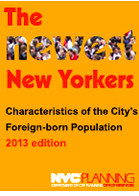
More than 3 million of the city's residents in 2011 were born in another country, out of a population of 8.2 million. That makes immigrants 37.2 percent of New York City dwellers, according to the 2013 edition of "The Newest New Yorkers," put together by the Population Division of the city Department of City Planning.
The last time the city had a higher share of immigrants was in 1910, when 41 percent of residents were foreign-born. The city's population at the time was 4.7 million, with immigrants accounting for 1.9 million residents.
The immigrant population has grown steadily since its low point in 1970, when 18 percent of residents, about 1.4 million, were immigrants in a city of 7.9 million people.
The latest report looks at the city's foreign-born population in a number of ways: where they come from, how they get here, where they settle, what jobs they take.
"All the boroughs of the city are more than ever the beneficiaries of our immigrant flows," said Joseph Salvo, director of the population division.
The report finds that while most of the city's immigrants live in Queens and Brooklyn, almost 2 million of them, the biggest jump between 2000 and 2011 was on Staten Island, where the number of foreign-born went from about 72,000 to about 98,000, a 36 percent increase.
The largest number of foreign-born New Yorkers comes from the Dominican Republic, about 380,000. Another 350,000 immigrants are from China, followed by Mexico, Jamaica, Guyana, Ecuador, Haiti, Trinidad and Tobago, India and Russia.
Salvo said the biggest flow of immigrants is from China, and if it continues, it's likely Chinese immigrants will become the largest foreign-born group in the city in a few years.
The diversity of the originating countries is what makes New York City unique in the nation, Salvo said. Other cities have large immigrant populations, but they're more likely to be from particular countries or specific regions of the world, he said.
In New York, "our immigration is more diverse than ever," he said, pointing to growing communities from countries like Ghana and Bangladesh.
It's something the city wants to see continue, Salvo said.
"The data shows as immigrants come in, they vitalize the neighborhoods, they change the city, they change who we are as a city."